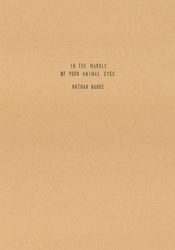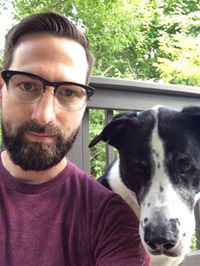
“Thinking you should be home already.” This line, which introduces the body of Hauke’s haunting book-length sequence In the Marble of your Animal Eyes, is swiftly followed by: “Bark scarred by antlers or whatever” (13). The scars (if not evidence of deer, than of what or whom?) seem like clues. And, in truth, In the Marble of your Animal Eyesis swarming with clues. But not the clues of a detective novel—painstakingly gathered, sifted and yoked to pattern, subject to logic—clues propagating conclusions that necessarily and irrefutably follow from established premises. The process at work in Hauke’s poetry is not one of deduction. Here, premises are often abandoned and choked with litter. Overgrown with weeds. Clues in this text do not snap neatly into well-manicured answers; they unravel into more questions (go to seed). And once clue begins to unravel back to its linguistic roots—for example, into earlier spellings (clywen, clew)—we can use the word(s) to navigate a fertile path leading from a ball formed by a winding thread 1 through a ball of thread, employed to guide anyone in ‘threading’ [her] way into or out of a labyrinth . . . or maze and from there to [t]hat which points the way, indicates a solution or puts one on the track of a discovery; a key. Pursuing such a track through the contemporary wilderness of Hauke’s poems seems like a productive reading strategy, not only when readers recall that Hauke prefaces his poem sequence with a re-examination (and reworking) of a dictionary entry for pastoral, but also when we examine In the Marble of your Animal Eyes more closely, look at specific threads:
Dandelions bark bright yellow Noisy where each exchange threads its glassy echo . . . (16).
[and]Crickets draw blue thread across black knit a pattern that grows between us (19).
[and]Kept working to gather clues, threads between my eye and a fat orange tabby On the porch while paint curled up off the back steps. Moonlight in the dark wood of the dresser that was our dresser (29).
In this last excerpt, references to thread are interlaced with references to clues, but clues that must be worked more than analyzed, clues that take on the properties of sight lines in what could be described as the book’s projective geometry. The clue-threads, and discrete images knotted along them, provide visionary perspectives that connect the poet’s (artist’s) eye to points of landscape—that guide the reader’s (viewer’s) eye into dynamic insights and intersections. Hauke’s clues weave the poem’s labyrinthine world as much as, or more than, they extract any single path out of it.
________________________________
To say that the primary movement of In the Marble of your Animal Eyes is not deductive may seem ironic, given that one of its most prominent features is Hauke’s use of cross-outs and strike-throughs (which have been gorgeously reproduced by Publication Studio in facsimile transcription). Superficially, of course, these editorial techniques could be viewed as a kind of subtraction, but Hauke’s use of such strategies transcends mere evidence of an erasure process. Words and phrases crossed from his lines are frequently recoverable, simultaneously stricken and underscored—after all, a strike-through is only hair-breadths away from an underline. And the variations in these cross-outs—in thickness, degree of opacity, angle, slant—only augment or amplify the language practices of the poems, add pressure and velocity. Add texture. To borrow a word from the manuscript, the cross-outs and other editorial markings add pitch. After spending enough time with Hauke’s poems, my experience of poetry that has evacuated all traces of texture from its process starts to feel almost too flat, too polished. Hauke’s technique and subject matter unite in the proposition that such erasure of texture can be analogous to an erasure of animality. Although the direct origin of In the Marble of your Animal Eyes is the Califone song, “Michigan Girls,” the book’s title immediately evokes a passage that Hauke has excerpted from Thoreau’s Journals:
I was struck
by the gem-like changeable greenish reflections
from the eyes of the grizzley bear
So glassy that you never saw
the surface of the eye (qtd in Hauke 31)
Just as a departed (lover’s) eyes may become the literal or metaphoric marble of a memorial to their loss, the eyes of a live grizzly caged in the menagerie are already the “gem-like” imitation of themselves that the taxidermist will embed. The unraveling marriage tracked through In the Marble of your Animal Eyes illustrates the conflict between polish and texture, between corporeal connection and deflective detachment. Potential instances of physical connection—“Pierced by the faint stubble of pubic hair / visible beneath the scrim of your nightgown” (20)—are juxtaposed with images of impermeable reclusion—“The isolation of your company falls apart” (30) or “You put your breath / on my mirror”4 (21). The wife has already begun reaching for “ . . .a mask that looks exactly like [her] face (23), has begun to vanish into polished surfaces like the “antique desk,” to which the speaker has applied “coats of varnish,” that will become a sewing table, writing desk / another place [she] begin[s] to disappear” (43). The juxtaposition of such moments converts the eye into a pendulum that swings between what we see through and what we see/are blocked from seeing through.
________________________________
 To grope beyond the texture thread (“track of discovery”) of In the Marble of your Animal Eyes is also instructive, to pull out a new speculative thread about the collection’s primary movement(s). Just as the speaker in Hauke’s poem, echoing an “[o]ld woman in the Trading Co.,” describes the permutations of one local Michigan business—“Before the funeral parlor became the Bank & Trust it was a porno theater . . .” (28)—(shifting through death to sex to money), the poems in this book resist stasis, stability, polish. This resistance is not produced exclusively by the added texture of manual editing. The poems’ engagement with movement itself, from the continual metamorphosis of recurrent images to the recombinatory sparks of specific syllables,5 give to the language of this work a radical, productive instability.
To grope beyond the texture thread (“track of discovery”) of In the Marble of your Animal Eyes is also instructive, to pull out a new speculative thread about the collection’s primary movement(s). Just as the speaker in Hauke’s poem, echoing an “[o]ld woman in the Trading Co.,” describes the permutations of one local Michigan business—“Before the funeral parlor became the Bank & Trust it was a porno theater . . .” (28)—(shifting through death to sex to money), the poems in this book resist stasis, stability, polish. This resistance is not produced exclusively by the added texture of manual editing. The poems’ engagement with movement itself, from the continual metamorphosis of recurrent images to the recombinatory sparks of specific syllables,5 give to the language of this work a radical, productive instability.
. . . when the surface shifts
water washes into old whitewashed tires.
But that place
doesn’t disappear.
These shifts,
destabilizations
Busted cattails frothing near a bottle of bleach. (49)
The poems, in content and in method, embrace continuous versus finished states. Even at the roots of language, the fluidity of single words between parts of speech, the writing resists determinacy. Hauke’s language draws a reader, for example, towards nouns that retain a (re)verbiness—salvage—over nouns that have ossified further into abstraction—salvation. Just as the word pitch becomes crucial for my understanding of the way Hauke’s cross-outs amplify the relationship between language and texture in his book, permutations of another word, wake, provide me with clarity on some of its other major concerns: wake (n) a trace or reverberation after passage; wake (v) to become roused or cognizant (to open one’s eyes); wake (n) a ritual of mourning. It is this last definition that highlights one of the deepest levels of engagement I experience with Hauke’s poems. As one of the book’s epigraphs reminds us (via Creeley): “[t]his life cannot be lived / apart from what it must forgive.” These poems remind me that the cost of productive instability, its necessary risk, is that such instability often occasions loss (and a need for forgiveness). How to embrace and transcend loss: this is a task I struggle with daily in my own life and writing. One tool helpful to me in this endeavor has been to imagine loss as Whitman describes death, as something “different from what any one supposed, and luckier” (ll. 130-131, Song of Myself). In the Marble of your Animal Eyes, unerringly inclined with this angle, gives me another. It reminds me that to over-polish language unproductively erases all marks and traces of work prior to the last, finishing touch. Many of Hauke’s editorial changes serve to resist the glossy exit line(s) of countless classic and contemporary poems (I, myself, am too often guilty of this tendency). The exit line designed to arrest, to (trans)fix. But, just as reassuringly, In the Marble of your Animal Eyes reminds me that nothing is ever irrevocably broken; it is merely breaking down. I occupy a moment of this book in the reading of it, but it will go on, and change, after me:
Pieces of light broken glass Cut sky behind shreds of bleached maple leaves Dark as bruised fruit in the distance
in the distance
where I think horizon (17).
________________________________
1 All definitions taken from The Oxford English Dictionary Online (2014)
2For more on the book’s pastoral thread, see Megan Burn’s insightful review in H_NGM_N 16: http://www.h-ngm-n.com/h_ngm_n-sixteen/megan-burns-on-nathan-hauke.html
3In it, Thoreau describes his visit to a menagerie on June 26, 1851.
4Breath on a mirror, of course, is also a classic test to see if someone—despite appearances—is alive.
5What Hauke pulls from Lucretius into the poems is this: “The particles” (qtd in Hauke 49).




